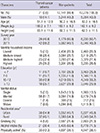1. Colonna M, Grosclaude P, Remontet L, Schvartz C, Mace-Lesech J, Velten M, Guizard A, Tretarre B, Buemi AV, Arveux P, et al. Incidence of thyroid cancer in adults recorded by French cancer registries (1978-1997). Eur J Cancer. 2002; 38:1762–1768.
2. Verkooijen HM, Fioretta G, Pache JC, Franceschi S, Raymond L, Schubert H, Bouchardy C. Diagnostic changes as a reason for the increase in papillary thyroid cancer incidence in Geneva, Switzerland. Cancer Causes Control. 2003; 14:13–17.
3. Reynolds RM, Weir J, Stockton DL, Brewster DH, Sandeep TC, Strachan MW. Changing trends in incidence and mortality of thyroid cancer in Scotland. Clin Endocrinol (Oxf). 2005; 62:156–162.
4. Hodgson NC, Button J, Solorzano CC. Thyroid cancer: is the incidence still increasing? Ann Surg Oncol. 2004; 11:1093–1097.
5. Liu S, Semenciw R, Ugnat AM, Mao Y. Increasing thyroid cancer incidence in Canada, 1970-1996: time trends and age-period-cohort effects. Br J Cancer. 2001; 85:1335–1339.
6. Burgess JR. Temporal trends for thyroid carcinoma in Australia: an increasing incidence of papillary thyroid carcinoma (1982-1997). Thyroid. 2002; 12:141–149.
7. Jung KW, Won YJ, Kong HJ, Oh CM, Seo HG, Lee JS. Cancer statistics in Korea: incidence, mortality, survival and prevalence in 2010. Cancer Res Treat. 2013; 45:1–14.
8. International Agency for Research on Cancer. GLOBOCAN 2008. accessed on 21 August 2013. Available at
http://globocan.iarc.fr.
9. Schneider AB, Ron E, Lubin J, Stovall M, Gierlowski TC. Dose-response relationships for radiation-induced thyroid cancer and thyroid nodules: evidence for the prolonged effects of radiation on the thyroid. J Clin Endocrinol Metab. 1993; 77:362–369.
10. Thompson DE, Mabuchi K, Ron E, Soda M, Tokunaga M, Ochikubo S, Sugimoto S, Ikeda T, Terasaki M, Izumi S, et al. Cancer incidence in atomic bomb survivors: part II: solid tumors, 1958-1987. Radiat Res. 1994; S17–S67.
11. Franceschi S. Iodine intake and thyroid carcinoma: a potential risk factor. Exp Clin Endocrinol Diabetes. 1998; 106:S38–S44.
12. Goodman MT, Kolonel LN, Wilkens LR. The association of body size, reproductive factors and thyroid cancer. Br J Cancer. 1992; 66:1180–1184.
13. Cote GJ, Wohllk N, Evans D, Goepfert H, Gagel RF. RET proto-oncogene mutations in multiple endocrine neoplasia type 2 and medullary thyroid carcinoma. Baillieres Clin Endocrinol Metab. 1995; 9:609–630.
14. Rossing MA, Cushing KL, Voigt LF, Wicklund KG, Daling JR. Risk of papillary thyroid cancer in women in relation to smoking and alcohol consumption. Epidemiology. 2000; 11:49–54.
15. Dal Maso L, La Vecchia C, Franceschi S, Preston-Martin S, Ron E, Levi F, Mack W, Mark SD, McTiernan A, Kolonel L, et al. A pooled analysis of thyroid cancer studies: V. anthropometric factors. Cancer Causes Control. 2000; 11:137–144.
16. Davies L, Welch HG. Increasing incidence of thyroid cancer in the United States, 1973-2002. JAMA. 2006; 295:2164–2167.
17. Rojeski MT, Gharib H. Nodular thyroid disease: evaluation and management. N Engl J Med. 1985; 313:428–436.
18. Ross DS. J Editorial: predicting thyroid malignancy. J Clin Endocrinol Metab. 2006; 91:4253–4255.
19. Liebeskind A, Sikora AG, Komisar A, Slavit D, Fried K. Rates of malignancy in incidentally discovered thyroid nodules evaluated with sonography and fine-needle aspiration. J Ultrasound Med. 2005; 24:629–634.
20. Enewold L, Zhu K, Ron E, Marrogi AJ, Stojadinovic A, Peoples GE, Devesa SS. Rising thyroid cancer incidence in the United States by demographic and tumor characteristics, 1980-2005. Cancer Epidemiol Biomarkers Prev. 2009; 18:784–791.
21. Fincham SM, Ugnat AM, Hill GB, Kreiger N, Mao Y. Is occupation a risk factor for thyroid cancer? Canadian Cancer Registries Epidemiology Research Group. J Occup Environ Med. 2000; 42:318–322.
22. Levi F, Franceschi S, Te VC, Negri E, Vecchia C. Descriptive epidemiology of thyroid cancer in the Swiss Canton of Vaud. J Cancer Res Clin Oncol. 1990; 116:639–647.
23. Haselkorn T, Bernstein L, Preston-Martin S, Cozen W, Mack WJ. Descriptive epidemiology of thyroid cancer in Los Angeles County, 1972-1995. Cancer Causes Control. 2000; 11:163–170.
24. Iribarren C, Haselkorn T, Tekawa IS, Friedman GD. Cohort study of thyroid cancer in a San Francisco Bay area population. Int J Cancer. 2001; 93:745–750.
25. Sprague BL, Warren Andersen S, Trentham-Dietz A. Thyroid cancer incidence and socioeconomic indicators of health care access. Cancer Causes Control. 2008; 19:585–593.
26. Han MA, Choi KS, Lee HY, Kim Y, Jun JK, Park EC. Current status of thyroid cancer screening in Korea: results from a nationwide interview survey. Asian Pac J Cancer Prev. 2011; 12:1657–1663.
27. Kim JM, Kim HM, Jung BY, Park EC, Cho WH, Lee SG. The association between cancer incidence and family income: analysis of Korean National Health Insurance cancer registration data. Asian Pac J Cancer Prev. 2012; 13:1371–1376.
28. Kim Y, Lee BK. Associations of blood lead, cadmium, and mercury with estimated glomerular filtration rate in the Korean general population: analysis of 2008-2010 Korean National Health and Nutrition Examination Survey data. Environ Res. 2012; 118:124–129.
29. Kilfoy BA, Zheng T, Holford TR, Han X, Ward MH, Sjodin A, Zhang Y, Bai Y, Zhu C, Guo GL, et al. International patterns and trends in thyroid cancer incidence, 1973-2002. Cancer Causes Control. 2009; 20:525–531.
30. Lee TJ, Kim S, Cho HJ, Lee JH. The incidence of thyroid cancer is affected by the characteristics of a healthcare system. J Korean Med Sci. 2012; 27:1491–1498.
31. Newacheck PW, Hung YY, Park MJ, Brindis CD, Irwin CE Jr. Disparities in adolescent health and health care: does socioeconomic status matter? Health Serv Res. 2003; 38:1235–1252.
32. Lazarus JH. Hyperthyroidism. Lancet. 1997; 349:339–343.
33. Zhang Y, Zhu Y, Risch HA. Changing incidence of thyroid cancer. JAMA. 2006; 296:1350.
34. Lee SH, Kim TY, Ryu JS, Gong G, Kim WB, Kim SC, Hong SJ, Shong YK. Trends analysis of characteristics of thyroid cancer patients in one medical center. J Korean Endocr Soc. 2008; 23:35–43.








 PDF
PDF ePub
ePub Citation
Citation Print
Print




 XML Download
XML Download